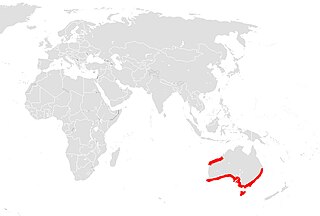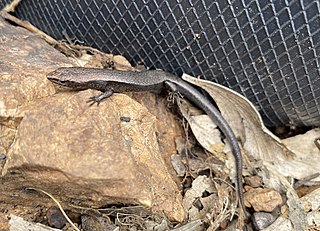
The Solomon Islands skink, also known as prehensile-tailed skink, monkey-tailed skink, giant skink, zebra skink, and monkey skink, is an arboreal species of skink endemic to the Solomon Islands archipelago. It is the largest known extant species of skink.

Lampropholis, the Indo-Australian ground skinks or sunskinks, are a genus of skinks in the lizard subfamily Eugongylinae. The genus Lampropholis was previously found to belong to a clade with the genera Niveoscincus, Leiolopisma and others of the Eugongylus group within Lygosominae. They are found mainly in Indonesia and Australia. For similar skinks see genera Bassiana, Pseudemoia, and Niveoscincus.

Carinascincus is a genus of skinks, commonly called snow skinks or cool-skinks and residing mainly in Tasmania or Victoria, Australia. Then recognised as the genus Niveoscincus, it was found to belong to a clade with the genera Carlia, Lampropholis and others of the Eugongylus group within Lygosominae. Cogger has rejected the use of the junior name Niveoscincus and recognizes the valid senior generic name Carinascincus for the group. For similar skinks see genera Pseudemoia, Lampropholis, and Bassiana. These skinks have adapted to the cooler weather of southern Australia and particularly Tasmania, hence the common names.

Pseudemoia is a genus of skinks native to southeastern Australia. For similar skinks see genera Bassiana, Lampropholis, and Niveoscincus.

Blue-tongued skinks comprise the Australasian genus Tiliqua, which contains some of the largest members of the skink family (Scincidae). They are commonly called blue-tongued lizards or simply blue-tongues or blueys in Australia. As suggested by these common names, a prominent characteristic of the genus is a large blue tongue that can be bared as bluff-warning to potential enemies. Depending on the type of predator/threat that is near will determine the intensity of colour present in the tongue. In addition, their blue tongue will produce a response in the prey which will in turn diminish the attack. The tongue also can also deform itself and produce a thick mucus in order to catch prey. They are relatively shy in comparison with other lizards, and also significantly slower due to their short legs.

Pedra Branca is a rock islet or small island, located in the Southern Ocean, off the southern coast of Tasmania, Australia. The island is situated approximately 26 kilometres (16 mi) south southeast of South East Cape and is contained within the Southwest National Park, part of the Tasmanian Wilderness World Heritage Site. An erosional remnant of the Tasmanian mainland, the island is approximately 270 metres (890 ft) long, 100 metres (330 ft) wide, with an elevation of 60 metres (200 ft) above sea level. The island is estimated to have separated from the Tasmanian mainland at least 15,000 years ago.

Mewstone is an unpopulated island, composed of muscovite granite, located close to the south coast of Tasmania, Australia. The 13.1-hectare (32-acre) island has steep cliffs and a small flat summit and is part of the Pedra Branca group, lying 12 kilometres (7.5 mi) southeast of Maatsuyker Island, and 22 kilometres (14 mi) off the south coast of Tasmania. Mewstone comprises part of the Southwest National Park and the Tasmanian Wilderness World Heritage Site.

Carinascincus metallicus, the metallic cool-skink or metallic skink is a species of skink in the family Scincidae. It is endemic to Australia, found in southern Victoria, as well as in Tasmania where it is the most widespread and common lizard, occurring on many offshore islands in Bass Strait as well as the mainland. It gives birth to live young. It is highly variable in colour and pattern, and may be a complex of closely related species.

The eastern three-lined skink, also known as the bold-striped cool-skink, is a species of skink, a lizard in the family Scincidae. The species is endemic to Australia. A. duperreyi has been extensively studied in the context of understand the evolution of learning, viviparity in lizards, and temperature- and genetic-sex determination. A. duperreyi is classified as a species of least concern by the IUCN.

The agile cool-skink or Tasmanian tree skink is a species of skink in the family Scincidae. It is endemic to Tasmania and the Bass Strait islands. It is viviparous, and may be found in a wide variety of habitats, from tall forests to rocky coastlines.

The southern grass skink is a species of lizard in the family Scincidae. The species is endemic to Australia, where it is found in the south-east of the continent, as well as in Tasmania and the islands of Bass Strait. Although it occurs in a variety of habitats, it is most commonly found in open grassy woodlands.

The Babel Island, part of the Babel Group within the Furneaux Group, is a 440-hectare (1,100-acre) granite island, located in Bass Strait, lying off the east coast of Flinders Island, Tasmania, south of Victoria, Australia. The privately owned island was named by Matthew Flinders from the noises made by the seabirds there.

Ligia australiensis, the Australian marine slater, is a woodlouse in the family Ligiidae.

Carinascincus coventryi, the southern forest cool-skink is a species of skink in the family Scincidae. It is endemic to Australia, found in Victoria southern New South Wales.
The alpine cool-skink is a species of skink in the family Scincidae. It is endemic to Australia, found in Tasmania.
Carinascincus microlepidotus, the boulder cool-skink or southern snow skink is a species of skink in the family Scincidae. It is endemic to Australia, found in Tasmania.

Pseudemoia baudini, also known commonly as Baudin's skink, Baudin's window-eyed skink, and the Bight Coast skink, is a species of lizard in the family Scincidae. The species is endemic to Australia.

Pseudemoia pagenstecheri, also known commonly as the southern grass tussock skink or the southern tussock grass skink, is a species of lizard in the family Scincidae. The species is endemic to Australia.

Pseudemoia rawlinsoni, also commonly known as the glossy grass skink and Rawlinson's window-eyed skink, is a species of lizard in the family Scincidae. The species is endemic to Australia.
















